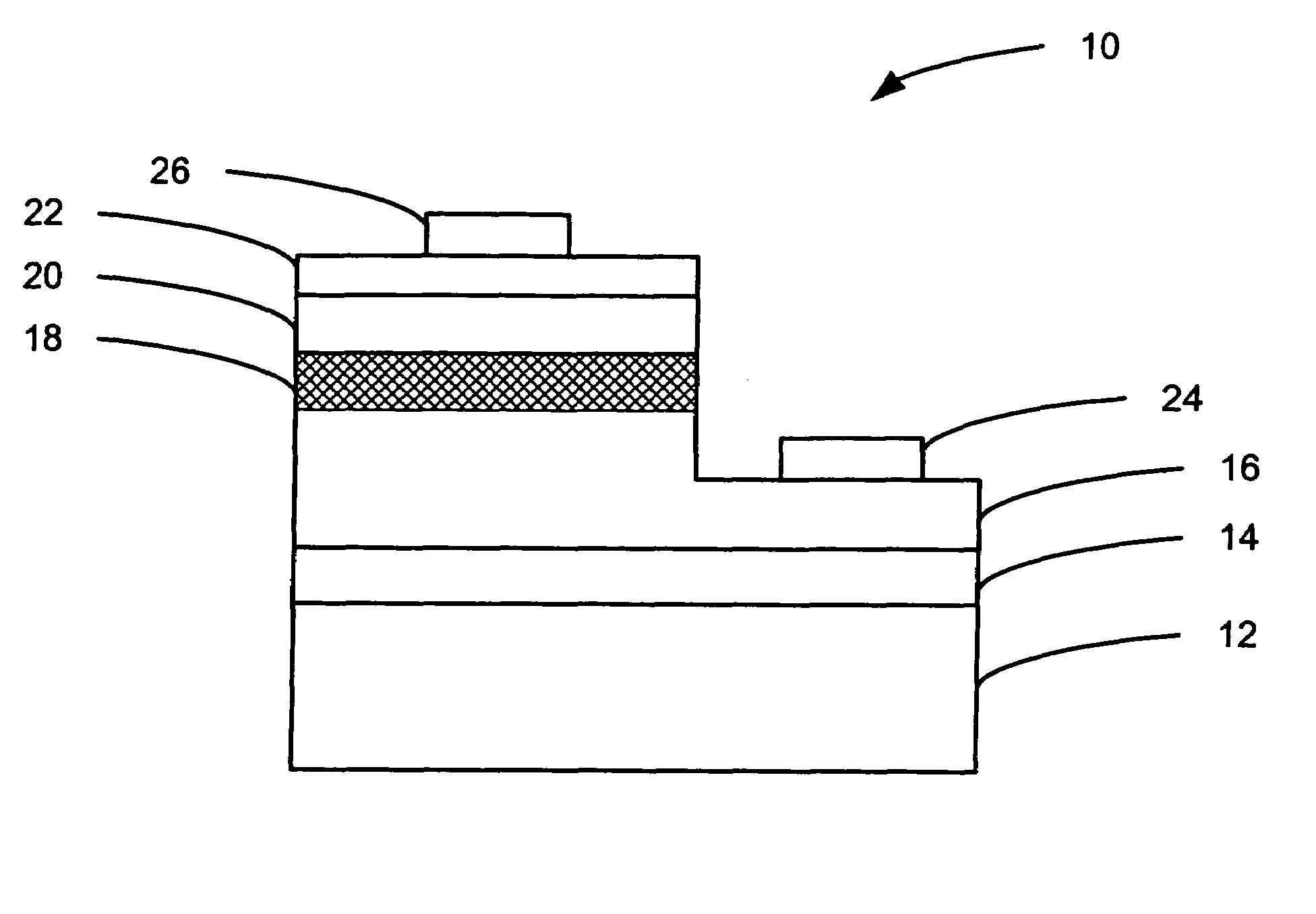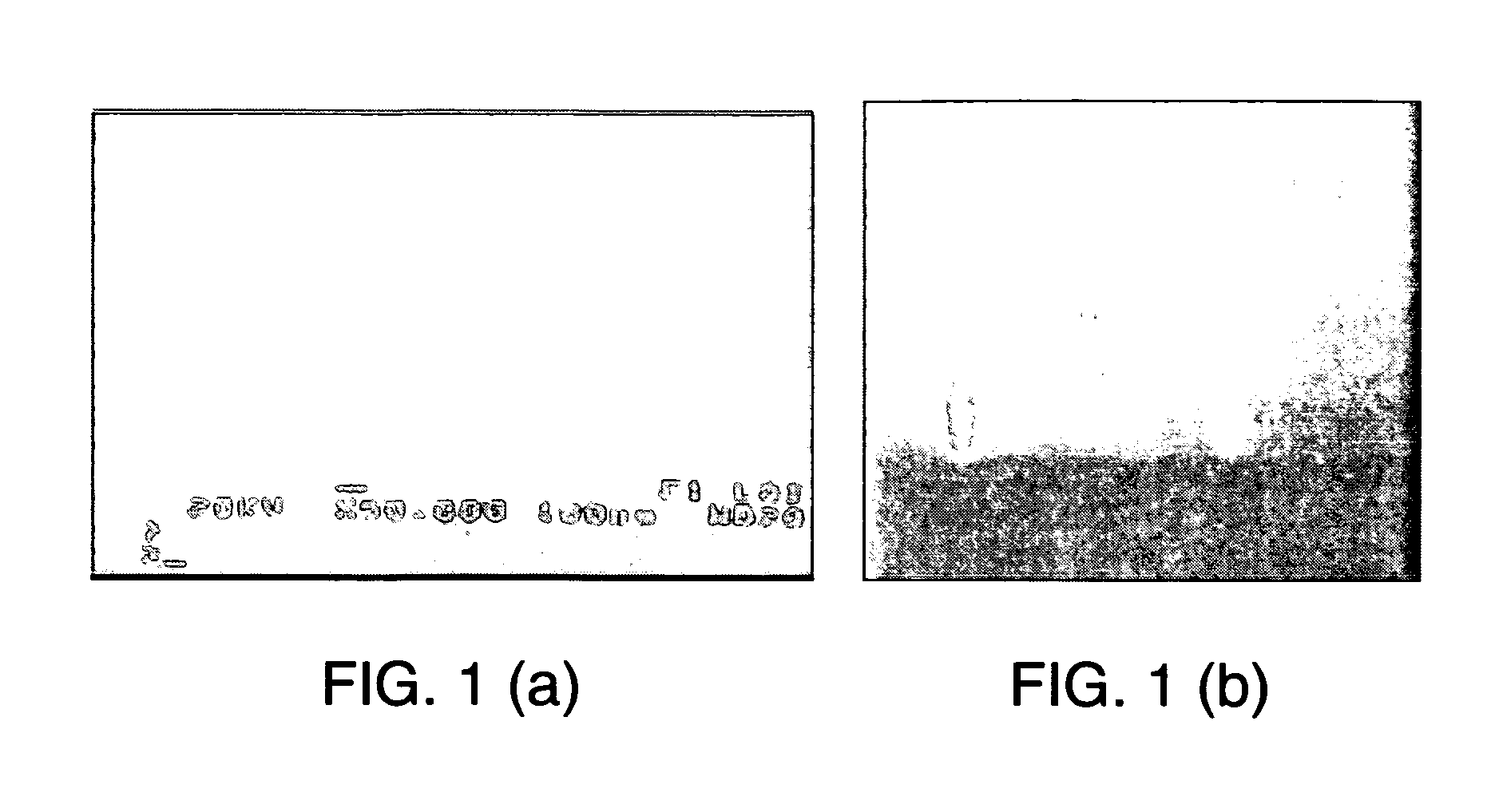Method of manufacturing an ultraviolet light emitting AlGaN composition and ultraviolet light emitting device containing same
a technology of light-emitting algan and composition, which is applied in the direction of semiconductor devices, laser optical resonator construction, lasers, etc., can solve the problems of lack of a native substrate for the homoepitaxial growth of epilayers, limited layer quality, and inconvenient use of ingan alloys in uv leds at wavelengths shorter than 365 nanometers, etc., to achieve enhanced radiative efficiency
- Summary
- Abstract
- Description
- Claims
- Application Information
AI Technical Summary
Problems solved by technology
Method used
Image
Examples
example 1
[0121]A DH (double heterostructure) UV-LED was fabricated according to the present method, using PA-MBE as described above. In particular, a n-type AlGaN current spreading layer having an AlN mole fraction of about 40% and a thickness of approximately 50 nm was deposited upon an AlGaN template. This n-type AlGaN current spreading layer was deposited under nitrogen limited conditions at a growth rate of about 220 nm / hr using nitrogen plasma conditions of about 300W rf power and about 0.6 sccm N2 gas flow rate. The substrate temperature employed was about 891° C., and the Al and Ga atom flux (as measured by BEP) were approximately 5.14×10−8 and 2.07×10−7 Torr respectively. The layer was intentionally doped n-type by incorporating about 1×1019 atoms / cm3 of silicon into the film by employing a Si effusion cell temperature of 1220° C.
[0122]Subsequently, an active region layer was deposited on top of the n-type AlGaN current spreading layer under nearly stoichiometric and nitrogen limited...
example 2
[0125]A DH (double heterostructure) UV-LED was fabricated according to the present method, using PA-MBE and utilizing a sapphire substrate as described above. First, the substrate was nitridated by heating to a temperature 831.6° C., and then the surface of the substrate was exposed to the nitrogen plasma source for 10 minutes. The plasma source conditions for this step were 300W rf power and 0.6 sccm. Thereafter, an AlN buffer layer, with an approximate thickness of 25 nm, was deposited atop the nitridated substrate utilizing an Al atom flux (as measured by BEP) of about 5.02×10−8 Torr and a growth rate of 220 nm / hr. The substrate temperature and nitrogen plasma conditions for this step were identical to that of the nitridation step.
[0126]Subsequently a n-type AlGaN current spreading layer having an AlN mole fraction of about 40% and thickness of about 1800 nm was deposited under nitrogen-limited conditions using a substrate temperature, growth rate and plasma source condition iden...
example 3
[0131]FIG. 21 shows a comparison of the photoluminescence lifetime in NCI AlGaN active region layers of present invention versus conventional AlGaN MQW (multiple quantum well) active region layers, deposited on both sapphire and a nitride semiconductor template. The conventional AlGaN MQW active region layers were designed for emission at 330 to 340 nm. They were deposited on a thin GaN template (buffer) on sapphire, and on a thick GaN HVPE free-standing substrate. The defect densities for the thin GaN template and the thick GaN substrate were estimated from etch pit counting by atomic force microscopy (AFM) to be ˜109 cm−2 and 107 cm−2, respectively.
[0132]It was found that the PL lifetime in the AlGaN MQW on the thin GaN template is about 100 ps, while for the AlGaN MQW on the thick GaN substrate the PL lifetime increases to about 500 ps (see G. A. Garrett, C. J. Collins, A. V. Sampath, H. Shen, M. Wraback, S. F. LeBoeuf, J. Flynn, and G. Brandes, Phys. Stat. Sol.(c) Vol. 2, No. 7,...
PUM
 Login to View More
Login to View More Abstract
Description
Claims
Application Information
 Login to View More
Login to View More - R&D
- Intellectual Property
- Life Sciences
- Materials
- Tech Scout
- Unparalleled Data Quality
- Higher Quality Content
- 60% Fewer Hallucinations
Browse by: Latest US Patents, China's latest patents, Technical Efficacy Thesaurus, Application Domain, Technology Topic, Popular Technical Reports.
© 2025 PatSnap. All rights reserved.Legal|Privacy policy|Modern Slavery Act Transparency Statement|Sitemap|About US| Contact US: help@patsnap.com



